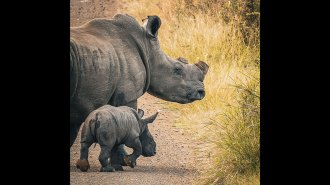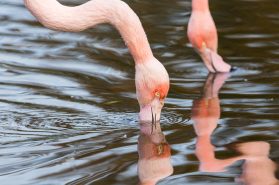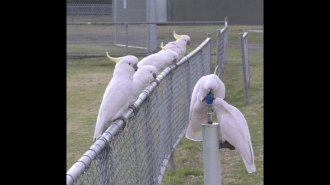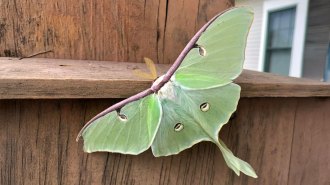Animals
-
 Animals
AnimalsPreemptively cutting rhinos’ horns cuts poaching
Comparing various tactics for protecting rhinos suggests that dehorning them drastically reduces poaching.
By Jake Buehler -
 Animals
AnimalsProbiotics helped great star corals fend off a deadly disease
A probiotic paste prevented the spread of stony coral tissue loss disease, but the treatment is still a proof-of-concept, not a cure.
-
 Animals
AnimalsFlamingos create precise water vortices in a shrimp-hunting frenzy
Nashville Zoo flamingos reveal the oddball birds generate many types of vortices to eat. The swirls could be an inspiration to human engineers.
By Elie Dolgin -
 Animals
AnimalsAussie cockatoos use their beaks and claws to turn on water fountains
Parrots living in Sydney have learned how to turn on water fountains for a drink. It's the first such drinking strategy seen in the birds.
By Jake Buehler -
 Animals
AnimalsHow luna moths grow extravagant wings
Warm temperatures, not just predator pressure, may favor luna moths’ long bat-fooling streamers, a geographic analysis of iNaturalist pics shows.
By Susan Milius -
 Animals
AnimalsGenetics might save the rare, elusive saola — if it’s not already extinct
A new genetic study could help saolas survive by enabling better searches through environmental DNA. But some experts fear they may be extinct already.
By Tom Metcalfe -
 Animals
AnimalsBedbugs may have been one of the first urban pests
Common bedbugs experienced a dramatic jump in population size about 13,000 years ago, around the time humans congregated in the first cities.
By Jake Buehler -
 Life
LifeThe first cicada concert was 47 million years ago
A 47-million-year-old cicada fossil from Germany’s Messel Pit could teach us about the evolution of insect communication.
-
 Climate
ClimatePenguin poop gives Antarctic cloud formation a boost
Penguin poop provides ammonia for cloud formation in coastal Antarctica, potentially helping to mitigate the impacts of climate change in the region.
-
 Animals
AnimalsJuvenile capuchins are kidnapping infants of another monkey species
Over 15 months on Jicarón Island, researchers saw five capuchin juveniles abduct 11 endangered howler monkey infants — all for no clear purpose.
By Freda Kreier -
 Animals
AnimalsA ‘talking’ ape’s death signals the end of an era
Kanzi showed apes have the capacity for language, but in recent years scientists have questioned the ethics of ape experiments.
By Erin Wayman -
 Science & Society
Science & SocietySome science seems silly, but it’s still worthwhile
The Salmon Cannon and the Levitating Frog contends that curiosity-driven research helps us understand the world and could lead to unexpected benefits.
By Karen Kwon